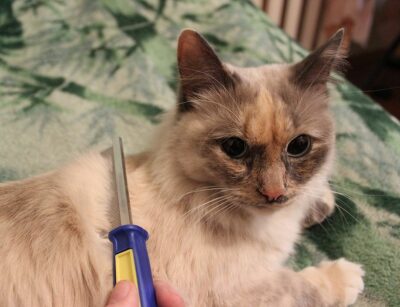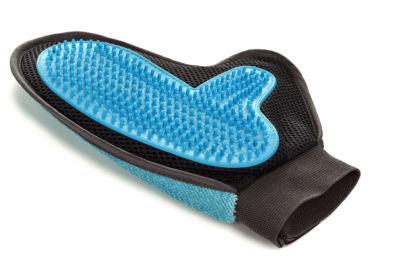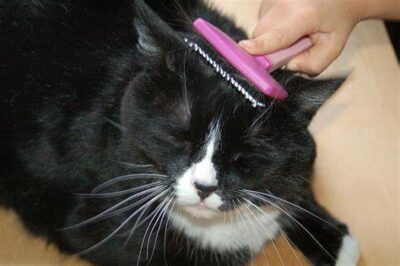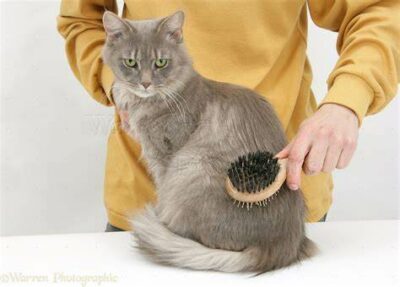Brush your cat, whether kitty has short or long hair. If you have a short-haired cat, brushing once a week is probably fine. If your cat has medium to long hair, though, you’d better plan on more than once a week, and every day if you can. So, do you know how to brush your cat properly?
Even though your cat grooms himself daily, he can use a little extra help from you. You will help keep his coat and skin healthy, and, most important, reduce the chance of hairballs. The brushing process will also help maintain your bond with your cat.
Pick a good time — select a time when the cat is calm and stress-free. You could brush kitty after a meal or when kitty is napping. Do your brushing on a schedule — select a time and then stick to it. It allows the cat to know what is coming.

I brush Mocha in the afternoon when he’s napping. There’s a nice sofa in my office, and most of the time the cat spends his afternoon there. By this time he owns one end of the sofa, as he always picks the same spot for his beauty sleep.
While he’s relaxed, I take advantage of the time. I have the brush, comb, and some treats ready for the session. I have been working with Mocha since he came to live here five months ago to try to stop him from biting. We are making progress, but some things elicit that bite response.
Brushing is one of them. He’s getting fine with the brushing of head, sides, and back. However, the tummy is another story. Because he has medium-long fur, that tummy really needs treatment from the brush, as it’s more apt to mat. Therefore, I use the gloves. Hopefully, I can go without them eventually.
One of my references suggests using a metal comb to brush from head to tail. Use the brush to remove dead hair. Use a rubber brush and bristle, and always be sure to be gentle…not just with the belly and chest area, but over the entire cat. A cat’s skin is quite sensitive. Gentle is best.
Of course, the brushing provides a good reward, just by helping the cat to remove unwanted fur and dirt. However, when you groom, you are also helping to remove parasites, such as fleas or ticks.
Parasites cause irritation, itchiness, and discomfort. That’s not their worst fault, as they can also lead to really harmful diseases.
The brushing helps remove dead skin cells and shedding hair. It also helps stimulate sebum production in the process. Sebum is a fatty lubricant secreted by the sebaceous glands of the skin. This lubricant coats, moisturizes, and protects the skin.

If your cat’s fur tends to mat, you have a serious need to groom kitty regularly. The mats not only make the coat look bad, but they can cause a lot of pain and discomfort. It might be worthwhile to invest in a mat-splitter if the cat is prone to matting.
Make sure you have a good-quality brush, as it can help both de-tangle and de-shed at the same time. You will receive the benefit of less shedding on furniture and on your clothes.
When you start, make sure kitty is comfortable. Get all your equipment together, and don’t forget to include a few cat treats, so kitty can enjoy them during the process. Let kitty smell the brush and rub against it so he’s aware of what’s going on.
Start by de-tangling any spots that need it. As you would do with your own hair, start at the base and work up to the root of the tangle. Be careful not to pull too much. If the tangle is really bad, you might want to use a mat-splitter. If your brush has long teeth, carefully brushing the spot could do the trick.
Then, once tangles are removed, give kitty a relaxing brush to smooth its fur and shedding hairs. This process will help prevent future mats. When you start brushing, it’s a good idea to begin with the cat’s back, as they might find this their favorite grooming spot.

With Mocha, I’ve found he likes his head and cheeks brushed, as they are favorite spots for a bit of scratching from his “mom.” Save the more sensitive areas, like stomach and legs, until last. Here’s where I put on gloves. Mocha doesn’t get really aggressive, but he will grab and bite.
A word of warning: Never try to force your cat to be brushed. If you meet with strong resistance and the cat really needs grooming, you should consider making an appointment with a professional groomer or veterinarian.
Perhaps you might try again, after a professional visit. With the right equipment, time, and treat inducement, you may gradually be able to get your cat used to regular brushing.
While most cats enjoy being brushed around the head, neck, and shoulders, other areas must be approached with caution. These include under the armpits, belly, rear legs and the tail. Go very gently when brushing, and especially in these areas.
If you find a bad tangle, it’s best to separate it out with your fingers, instead of yanking on the coat and making the cat uncomfortable and/or mad. Use smooth, gentle movements; don’t jerk. When kitty tells you “that’s enough,” pay attention and stop for that session.

At first, sessions should be quite short, anyway, to let the cat get used to the process. Positive reinforcement during these sessions is essential. Eventually, the cat will come to associate the brushing with treats, and he will look forward to your sessions.
Just remember — take it slow and easy and let kitty get used to brushing. Once he discovers it’s a way to interact with “Mom” and be guaranteed treats, he may come to look forward to your sessions. Tell him how beautiful he looks…maybe he will understand.
References I used for this post: hepper.com/tips-on-how-to-brush-a-cat/ tangleteezer.com/us/discover/pet-inspiration/cat/cat-grooming-101-how-to-groom-your-cat alphapaw.com/blog/how-to-properly-groom-your-cat-at-home/ petmd.com/cat/grooming/how-brush-cat

